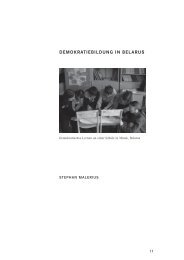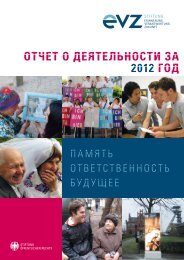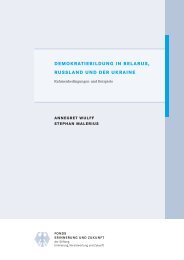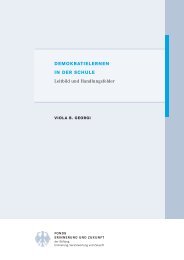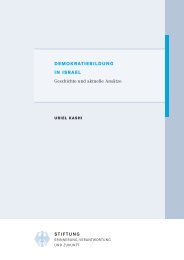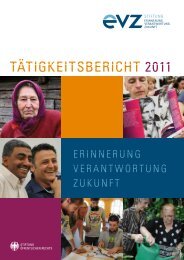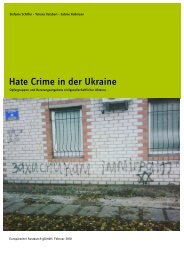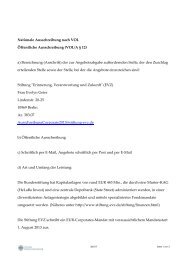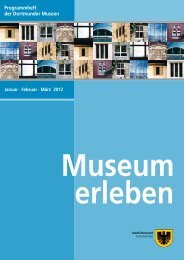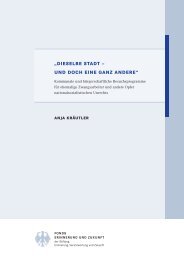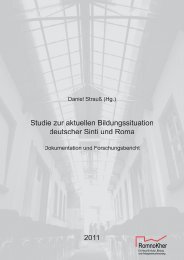chapter 2 - Stiftung "Erinnerung, Verantwortung und Zukunft"
chapter 2 - Stiftung "Erinnerung, Verantwortung und Zukunft"
chapter 2 - Stiftung "Erinnerung, Verantwortung und Zukunft"
Create successful ePaper yourself
Turn your PDF publications into a flip-book with our unique Google optimized e-Paper software.
Agnès Callamard<br />
F<strong>und</strong>amental reform of the legal regime governing freedom of expression is therefore an essential precondition<br />
for meaningful efforts to uncover the truth about the past. From this standpoint, it may be argued that<br />
the right to truth derives from the more general right of access to information, contained within the right to<br />
“seek, receive and impart information” which is guaranteed by Article 19 of the Universal Declaration of Human<br />
Rights.<br />
Both legal practice and jurisprudence aro<strong>und</strong> the world have increasingly insisted that the truth be made<br />
public. Indeed, the right to “truth” is first and foremost a right to an official statement about what happened,<br />
or “to an authoritative version of events, over and above partisan considerations.” 7<br />
As Yasmin Naqvi argues, “such ‘statements’ by the state need not be in a particular form but could be expressed<br />
aurally, visually, musically, pictorially or through sculpture. This could mean that the right to the<br />
truth could also be, at least partially, satisfied through such actions by the state as erecting monuments dedicated<br />
to victims or works of art or musical compositions that explain what happened.” 8<br />
The right to truth does not preclude the rights of victims to compensation or punishments for perpetrators.<br />
Over the last 20 years, myriad approaches to the right to truth have evolved, that include criminal prosecutions,<br />
reconciliation and amnesties. All have requested freedom of expression and demand that the state to<br />
uncover and publicize the truth.<br />
Limitations to the Right to Truth<br />
In spite of its multiple functions, the right to truth is not absolute; it is limited by the same exceptions that<br />
apply to the right of expression more generally <strong>und</strong>er Article 19 of the International Covenant on Civil and<br />
Political Rights. Framed in general terms, these exceptions allow governments to withhold certain types of<br />
information from the public. For example, the right to freedom of expression may be restricted in order to<br />
protect the rights of others, or public order, if it is “necessary in a democratic society” and is done by law.<br />
The European Court has established a strict three-part test for the restriction of freedom of expression. For<br />
a restriction to be legitimate, it must meet all three parts of the test: a restriction must indeed pursue the<br />
legitimate aim that it claims to pursue; the restriction must be imposed in a democratic framework (i.e., either<br />
by parliament or pursuant to powers granted by parliament); and the restriction must be “necessary in<br />
a democratic society.” The word “necessary” must be taken quite literally and means that a restriction must<br />
not be merely “useful” or “reasonable.” States maintain discretion over the exact measures, but above all<br />
their restrictions must be “necessary in a democratic society.” There should be a clear presumption in favor<br />
of the right to information about serious human rights violations. The onus falls on the authorities to justify a<br />
refusal to make information available upon request.<br />
International law imposes one clear positive duty on states: as stated in Article 20(2) of the UN Covenant on<br />
Civil and Political Rights: “Any advocacy of national, racial or religious hatred that constitutes incitement to<br />
discrimination, hostility or violence shall be prohibited by law.” 9 Yet there are vastly different regional or national<br />
approaches to hate speech. At one end of the spectrum, the US approach protects hate speech unless the<br />
speech actually incites violence or is likely to give rise to imminent violence. It is a stringent standard which<br />
means that even speech advocating violence and filled with racial insults is protected if there is no evidence<br />
that physical violence is likely to occur. At the other hand of the spectrum are tight restrictions on hate speech,<br />
7 José Zalaquett, quoted in ARTICLE 19: Moments of Truth in Sierra Leone (London, August 2000): 10-11, accessed on Oct. 29, 2009 from http://www.<br />
article19.org/pdfs/publications/sierra-leone-moments-of-truth.pdf.<br />
8 Yasmin Naqvi, “The Right to the Truth in International Law: Fact or Fiction?” in International Review of the Red Cross 88 (June 2006): 862 ff.<br />
9 United Nations, International Covenant on Civil and Political Rights, accessed on Jan. 31, 2010 from http://www.hrweb.org/legal/cpr.html.<br />
102<br />
<strong>Stiftung</strong> EVZ<br />
HUMAN RIGHTS AND HISTORY: A CHALLENGE FOR EDUCATION



